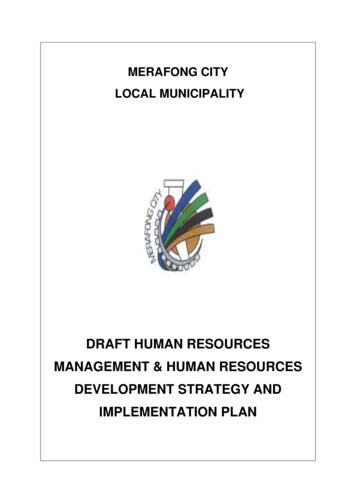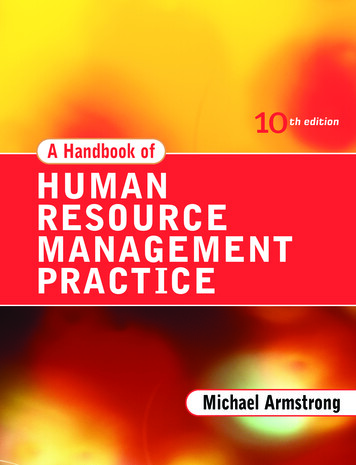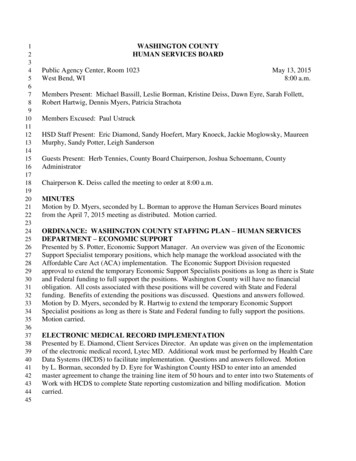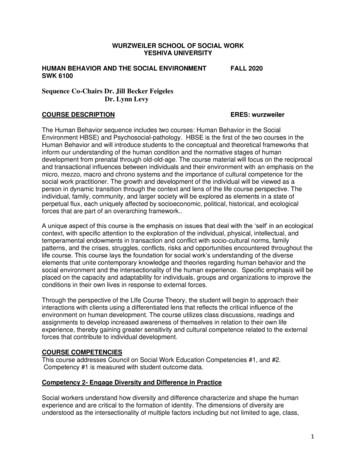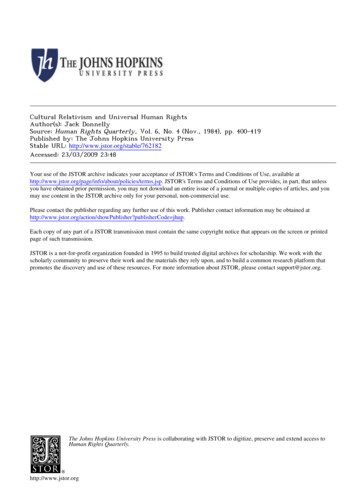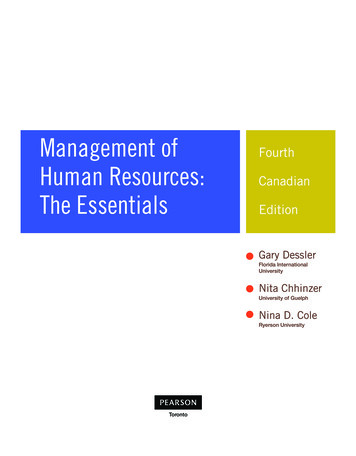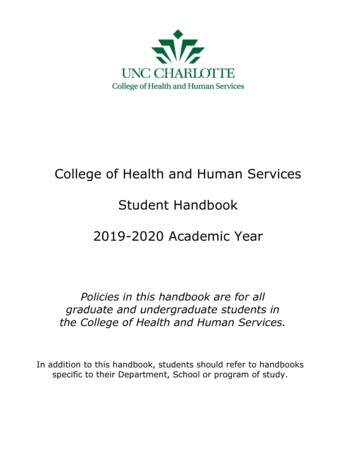
Transcription
The Department of Health and Human Services has submitted this rule to the Office ofthe Federal Register. The official version of the rule will be published in the FederalRegister.DEPARTMENT OF HEALTH AND HUMAN SERVICESCenters for Medicare & Medicaid Services42 CFR Parts 510 and 512[CMS-5519-P]RIN 0938-AS90Medicare Program; Advancing Care Coordination Through Episode Payment Models(EPMs); Cardiac Rehabilitation Incentive Payment Model; and Changes to theComprehensive Care for Joint Replacement Model (CJR)AGENCY: Centers for Medicare & Medicaid Services (CMS), HHS.ACTION: Proposed rule.SUMMARY: This proposed rule proposes to implement three new Medicare Parts A and Bepisode payment models under section 1115A of the Social Security Act. Acute care hospitals incertain selected geographic areas will participate in retrospective episode payment modelstargeting care for Medicare fee-for-service beneficiaries receiving services during acutemyocardial infarction, coronary artery bypass graft, and surgical hip/femur fracture treatmentepisodes. All related care within 90 days of hospital discharge will be included in the episode ofcare. We believe this model will further our goals of improving the efficiency and quality ofcare for Medicare beneficiaries receiving care for these common clinical conditions andprocedures. This proposed rule also includes several proposed modifications to theComprehensive Care for Joint Replacement model.
CMS-5519-P2DATES: Comment period: To be assured consideration, comments on this proposed rule mustbe received at one of the addresses provided in the ADDRESSES section no later than 5 p.m.EDT on [Insert date 60 days from date of publication by the Office of the Federal Register].ADDRESSES: In commenting, please refer to file code CMS-5519-P. Because of staff andresource limitations, we cannot accept comments by facsimile (FAX) transmission.You may submit comments in one of four ways (please choose only one of the wayslisted):1. Electronically. You may submit electronic comments on this regulation tohttp://www.regulations.gov. Follow the "Submit a comment" instructions.2. By regular mail. You may mail written comments to the following address ONLY:Centers for Medicare & Medicaid Services,Department of Health and Human Services,Attention: CMS-5519-P,P.O. Box 8013,Baltimore, MD 21244-1850.Please allow sufficient time for mailed comments to be received before the close of thecomment period.3. By express or overnight mail. You may send written comments to the followingaddress ONLY:Centers for Medicare & Medicaid Services,Department of Health and Human Services,Attention: CMS-5519-P,
CMS-5519-P3Mail Stop C4-26-05,7500 Security Boulevard,Baltimore, MD 21244-1850.4. By hand or courier. Alternatively, you may deliver (by hand or courier) your writtencomments ONLY to the following addresses prior to the close of the comment period:a. For delivery in Washington, DC-Centers for Medicare & Medicaid Services,Department of Health and Human Services,Room 445-G, Hubert H. Humphrey Building,200 Independence Avenue, SW.,Washington, DC 20201(Because access to the interior of the Hubert H. Humphrey Building is not readilyavailable to persons without federal government identification, commenters are encouraged toleave their comments in the CMS drop slots located in the main lobby of the building. Astamp-in clock is available for persons wishing to retain a proof of filing by stamping in andretaining an extra copy of the comments being filed.)
CMS-5519-P4b. For delivery in Baltimore, MD-Centers for Medicare & Medicaid Services,Department of Health and Human Services,7500 Security Boulevard,Baltimore, MD 21244-1850.If you intend to deliver your comments to the Baltimoreaddress, call telephone number (410) 786-7195 in advance to schedule your arrival with one ofour staff members.Comments erroneously mailed to the addresses indicated as appropriate for hand orcourier delivery may be delayed and received after the comment period.For information on viewing public comments, see the beginning of the"SUPPLEMENTARY INFORMATION" section.FOR FURTHER INFORMATION CONTACT:For questions related to the proposed EPMs: NEPMRULE@cms.hhs.govFor questions related to the CJR model: CJR@cms.hhs.govSUPPLEMENTARY INFORMATION:Inspection of Public Comments: All comments received before the close of the comment periodare available for viewing by the public, including any personally identifiable or confidentialbusiness information that is included in a comment. We post all comments received before theclose of the comment period on the following Web site as soon as possible after they have beenreceived: http://www.regulations.gov . Follow the search instructions on that Web site to viewpublic comments.
CMS-5519-P5Comments received timely will also be available for public inspection as they arereceived, generally beginning approximately 3 weeks after publication of a document, at theheadquarters of the Centers for Medicare & Medicaid Services, 7500 Security Boulevard,Baltimore, Maryland 21244, Monday through Friday of each week from 8:30 a.m. to 4 p.m. Toschedule an appointment to view public comments, phone 1-800-743-3951.Electronic AccessThis Federal Register document is also available from the Federal Register onlinedatabase through Federal Digital System (FDsys), a service of the U.S. Government PrintingOffice. This database can be accessed via the internet at http://www.gpo.gov/fdsys/ .Alphabetical List of AcronymsBecause of the many terms to which we refer by acronym, abbreviation, or short form inthis proposed rule, we are listing the acronyms, abbreviations and short forms used and theircorresponding terms in alphabetical order.ACEAcute-care episodeACOAccountable Care OrganizationALOSAverage length of stayAMAAmerican Medical AssociationAMIAcute Myocardial InfarctionAPMAlternative Payment ModelASC QRPAmbulatory Surgical Center Quality Reporting ProgramASCAmbulatory Surgical CenterASPEAssistant Secretary for Planning and Evaluation
CMS-5519-P6BPCIBundled Payments for Care ImprovementCABGCoronary Artery Bypass GraftCADCoronary artery diseaseCAHCritical access hospitalCBSACore-Based Statistical AreaCCComplication or comorbidityCCDAConsolidated clinical document architectureCCDECore clinical data elementsCCNCMS Certification NumberCECComprehensive ESRD Care InitiativeCEHRTCertified Electronic Health Record TechnologyCFRCode of Federal RegulationsCJRComprehensive Care for Joint ReplacementCMHCCommunity Mental Health CenterCMICase Mix IndexCMMICenter for Medicare and Medicaid InnovationCMPCivil monetary penaltyCMSCenters for Medicare & Medicaid ServicesCoPCondition of ParticipationCPCComprehensive Primary Care InitiativeCPTCurrent Procedural TerminologyCRCardiac rehabilitation
CMS-5519-P7CSACombined Statistical AreaCVICUCardiovascular intensive care unitsCYCalendar yearDMEDurable medical equipmentDMEPOSDurable medical equipment, prosthetics, orthotics, and suppliesDSHDisproportionate Share HospitalECQMElectronic Clinical Quality MeasuresEFTElectronic funds transferEHRElectronic health recordE/MEvaluation and managementEPMEpisode payment modelESCOESRD Seamless Care OrganizationESRDEnd-Stage Renal DiseaseFFSFee-for-serviceGAAPGenerally-Accepted Accounting PrinciplesGEMGeneral Equivalence MappingGPCIGeographic Practice Cost IndexHACHospital-Acquired ConditionHACRPHospital-Acquired Condition Reduction ProgramHCAHPSHospital Consumer Assessment of Healthcare Providers and SystemsHCCHierarchical Condition CategoryHCPCSHealthcare Common Procedure Coding System
CMS-5519-P8HHAHome health agencyHHPPSHome Health Prospective Payment SystemHHRGHome Health Resource GroupHHSU.S. Department of Health and Human ServicesHH QRPHome Health Quality Reporting ProgramHICNHealth Insurance Claim NumberHIPPAHealth Insurance Portability and Accountability ActHIQRHospital Inpatient Quality ReportingHealth ITHealth Information TechnologyHLMRHCAHPS Linear Mean Roll UpHOOSHip Dysfunction and Osteoarthritis Outcome ScoreHOPDHospital outpatient departmentHRRPHospital Readmissions Reductions ProgramHRRHospital Referral RegionHVBPHospital Value-Based Purchasing ProgramHIVHuman Immunodeficiency VirusICD-9-CMInternational Classification of Diseases, 9th Revision, Clinical ModificationICD-10-CMInternational Classification of Diseases, 10th Revision, Clinical ModificationICRIntensive Cardiac RehabilitationIMEIndirect medical educationIPPSInpatient Prospective Payment SystemIPFInpatient psychiatric facility
CMS-5519-P9IRF QRPInpatient Rehabilitation Facility Quality Reporting ProgramIPF QRPInpatient Psychiatric Facility Quality Reporting ProgramIRFInpatient rehabilitation facilityKOOSKnee Injury and Osteoarthritis Outcome ScoreLEJRLower-extremity joint replacementLIPLow-income percentageLOSLength-of-stayLTCH QRPLong-Term Care Hospital Quality Reporting ProgramLTCHLong-term care hospitalLUPALow-utilization payment adjustmentMACMedicare Administrative ContractorMACRAMedicare Access and CHIP Reauthorization Act of 2015MAPCPMulti-Payer Advanced Primary Care PracticeMATMeasure Authoring ToolMCCMajor complications or comorbiditiesMCCMMedicare Care Choices ModelMDCMajor diagnostic categoryMDHMedicare-Dependent HospitalMedPACMedicare Payment Advisory CommissionMIPSMerit-based Incentive Payment SystemMPMalpracticeMSAMetropolitan Statistical Area
CMS-5519-P10MS-DRGMedical Severity Diagnosis-Related GroupNPINational Provider IdentifierNPRANet Payment Reconciliation AmountNQFNational Quality ForumOCMOncology Care ModelOIGDepartment of Health and Human Services' Office of the Inspector GeneralOPPSOutpatient Prospective Payment SystemOQROutpatient Quality ReportingPBPMPer-beneficiary per-monthPCIPercutaneous Coronary InterventionPCMHPrimary Care Medical HomesPEPractice ExpensePFSPhysician Fee SchedulePGPPhysician group practicePQRSPhysician Quality Reporting SystemPHAPartial hip arthroplastyPPSProspective Payment SystemPROPatient-Reported OutcomePROMISPatient-Reported Outcomes Measurement Information SystemsPRO-PMPatient-Reported Outcome Performance MeasurePTCAPercutaneous transluminal coronary angioplastyPYPerformance year
CMS-5519-P11QIOQuality Improvement OrganizationRACRecovery Audit ContractorRRCRural Referral CenterRSCRRisk-Standardized Complication RateRSRRRisk-Standardized Readmission RateRSMRRisk-Standardized Mortality RateRVURelative Value UnitSCHSole Community HospitalSHFFTSurgical hip/femur fracture treatmentSILS2Single Item Health Literacy ScreeningSNFQRP Skilled Nursing Facility Quality Reporting ProgramSNFSkilled nursing facilityTHATotal hip arthroplastyTINTaxpayer identification numberTKATotal knee arthroplastyTPTarget priceUHDDSUniform Hospital Discharge Data SetVR-12Veterans Rand 12 Item Health SurveyTable of ContentsI. Executive SummaryA. PurposeB. Summary of the Major Provisions
CMS-5519-P1. Model Overview – EPM episodes of care2. Model Scope3. Payment4. Similar, Previous, and Concurrent Models5. Overlap with Ongoing CMS Efforts6. Quality Measures and Reporting Requirements7. Beneficiary Protections8. Financial Arrangements9. Data Sharing10. Program WaiversC. Summary of Economic EffectsII. BackgroundIII. Provisions of the Proposed Regulations12
CMS-5519-P13A. Selection of Episodes for Episode Payment Models in this Rulemaking and Potential FutureDirections1. Selection of Episodes for Episode Payment Models in this Rulemakinga. Overviewb. SHFFT Modelc. AMI and CABG Models2. Advanced Alternative Payment Model Considerationsa. Overview for the EPMsb. EPM Participant Tracksc. Clinician Financial Arrangements Lists under the EPMsd. Documentation Requirements3. Future Directions for Episode Payment Modelsa. Refinements to the BPCI Initiative Modelsb. Potential Future Condition-Specific Episode Payment Modelsc. Potential Future Event-Based Episode Payment Models for Procedures and MedicalConditionsd. Health Information Technology Readiness for Potential Future Episode Payment ModelsB. Proposed Definition of the Episode Initiator and Selected Geographic Areas1. Background2. Proposed definition of episode initiator3. Financial responsibility for episode of care
CMS-5519-P144. Proposed Geographic Unit of Selection and Exclusion of Selected Hospitals5. Overview and Options for Geographic Area Selection for AMI and CABG Episodesa. Exclusion of Certain MSAsb. Proposed Selection Approach(1) Factors Considered but Not Used(2) Sample Size Calculations and the Number of Selected MSAs(3) Method of Selecting MSAsC. Episode Definition for EPMs1. Background2. Overview of Proposed Three New Episode Payment Models3. Clinical Dimensions of AMI, CABG, and SHFFT Model Episodesa. Definition of the Clinical Conditions Included in AMI, CABG, and SHFFT Model Episodes(1) AMI (Medical Management and PCI) Model(2) CABG Model(3) SHFFT (Excludes Lower Extremity Joint Replacement) Modelb. Definition of the Related Services Included in EPM Episodes4. EPM Episodesa. Beneficiary Care Inclusion Criteria and Beginning of EPM Episodes(1) General Beneficiary Care Inclusion Criteria(2) Beginning AMI Model Episodes(3) Beginning CABG Model Episodes(4) Beginning SHFFT Episodes
CMS-5519-P15(5) Special Policies for Hospital Transfers of Beneficiaries with AMIb. Middle of EPM Episodesc. End of EPM Episodes(1) AMI and CABG Models(2) SHFFT ModelD. Methodology for Setting EPM Episode Prices and Paying EPM Participants in the AMI,CABG, and SHFFT Models1. Backgrounda. Overviewb. Key Terms for EPM Episode Pricing and Payment2. Performance Years, Retrospective Episode Payments, and Two-Sided Risk EPMsa. Performance Periodb. Retrospective Payment Methodologyc. Two-Sided Risk EPMs3. Adjustments to Actual EPM Episode Payments and to Historical Episode Payments used toSet Episode Pricesa. Overviewb. Special Payment Provisionsc. Services that Straddle Episodesd. High-Payment EPM Episodese. Treatment of Reconciliation Payments and Medicare Repayments when Calculating HistoricalEPM-Episode Payments to Update EPM Benchmark and Quality-Adjusted Target Prices
CMS-5519-P164. EPM-Episode Price-Setting Methodologiesa. Overview(1) AMI model(2) CABG model(3) SHFFT modelb. EPM Episode Benchmark and Quality-Adjusted Target Price Features(1) Risk-Stratifying EPM-Episode Benchmark Prices based on MS–DRG and Diagnosis(2) Adjustments to Account for EPM-Episode Price Variation(a) Adjustments for Certain AMI Model Episodes with Chained Anchor Hospitalizations(b) Adjustments for CABG Model Episodes(c) Adjustments for Certain AMI Model Episodes with CABG Readmissions(d) Potential Future Approaches to setting Target Prices for AMI and Hip Fracture Episodes(e) Summary of Pricing Methodologies for AMI, CABG, and SHFFT Model Episode Scenarios(3) 3 Years of Historical Data(4) Trending Historical Data to the Most Recent Year(5) Update Historical EPM-Episode Payments for Ongoing Payment System Updates(6) Blend Hospital-Specific and Regional Historical Data(7) Define Regions as U.S. Census Divisions(8) Normalize for Provider-Specific Wage Adjustment Variations(9) Combining Episodes to Set Stable Benchmark and Quality-Adjusted Target Prices(10) Effective Discount Factors
CMS-5519-P17c. Approach to Combine Pricing Features for all SHFFT Model Episodes and AMI ModelEpisodes without CABG readmissionsd. Approach to Combine Pricing Features for CABG Model Episodes(1) Anchor Hospitalization Portion of CABG Model Episodes(2) Approach to Combine Pricing Features for Post-Anchor Hospitalization Portion of CABGModel Episodes(3) Combine CABG Anchor Hospitalization Benchmark Price and CABG Post-AnchorHospitalization Benchmark Pricee. Approach to Combine Pricing Features for AMI Model episodes with CABG Readmissions5. Process for Reconciliationa. Net Payment Reconciliation Amount (NPRA)b. Payment Reconciliationc. Reconciliation Report6. Adjustments for Overlaps with Other Innovation Center Models and CMS Programsa. Overviewb. Provider Overlap(1) BPCI Participant Hospitals in Geographic Areas Selected for EPMs(2) BPCI Physician Group Practice (PGP) Episode Initiators in Hospitals Participating in EPMsc. Beneficiary Overlap(1) Beneficiary Overlap with BPCI(2) Beneficiary Overlap with the CJR Model and other EPMs(3) Beneficiary Overlap with Shared Savings Models and Programs
CMS-5519-P18d. Payment Reconciliation of Overlap with non-ACO CMS Models and Programs7. Limits or Adjustments to EPM Participants' Financial Responsibilitya. Overviewb. Limit on Actual EPM-Episode Payment Contribution to Repayment Amounts andReconciliation Payments(1) Limit on Actual EPM-Episode Payment Contribution to Repayment Amounts(2) Limitation on Reconciliation Paymentsc. Additional Protections for Certain EPM Participants(1) Proposed Policies for Certain EPM Participants to Further Limit Repayment Responsibility(2) Considerations for Hospitals Serving a High Percentage of Potentially VulnerablePopulationsd. Application of Stop-Gain and Stop-Loss Limitse. EPM Participant Responsibility for Increased Post-Episode Payments8. Appeals Processa. Overviewb. Notice of calculation error (first level appeal)c. Dispute Resolution Process (second level of appeal)d. Exception to the Notice of Calculation Error Process and Notice of Terminatione. Limitations on reviewE. EPM quality measures, public display, and use of quality measures in the EPM paymentmethodology1. Background
CMS-5519-P192. Selection of Proposed Quality Measures for the EPMsa. Overview of Quality Measure Selectionb. AMI Model Quality Measuresc. CABG Model Quality Measuresd. SHFFT Model Quality Measures3. Proposed Use of Quality Measures in the EPM Payment Methodologiesa. Overview of EPM Composite Quality Score Methodologyb. Determining Quality Measure Performancec. Determining Quality Measure Improvementd. Determining Successful Submission of Voluntary Data for AMI and SHFFT Models(1) Hybrid AMI Mortality (NQF #2473) Voluntary Data(2) Patient-Reported Outcomes and Limited Risk Variable Voluntary Data Following ElectivePrimary THA/TKAe. Calculation of the EPM-Specific Composite Quality Score(1) AMI Model Composite Quality Score(2) CABG Model Composite Quality Score(3) SHFFT Model Composite Quality Scoref. EPM Pay-for-Performance Methodologies to Link Quality and Payment
CMS-5519-P20(1) Overview of Pay-for-Performance Proposals Applicable to the EPMs(2) AMI and CABG Model Pay-for-Performance Methodology(a) AMI Model Pay-for-Performance Methodology(b) CABG Model Pay-for-Performance Methodology(c) Interface Considerations for the AMI and CABG Model Methodologies(3) SHFFT Model Pay-for-Performance Methodology4. Details on Quality Measures for the EPMsa. AMI Model-Specific Measures(1) Hospital 30-Day, All-Cause, Risk-Standardized Mortality Rate Following Acute MyocardialInfarction (AMI) Hospitalization (NQF #0230) (MORT-30-AMI)(a) Background(b) Data Sources(c) Cohort(d) Inclusion and Exclusion Criteria(e) Risk-Adjustment(f) Calculating the Risk-Standardized Mortality Ratio (RSMR) and Performance Period(2) Excess Days in Acute Care after Hospitalization for Acute Myocardial Infarction (AMIExcess Days)(a) Background(b) Data Sources(c) Cohort(d) Inclusion and Exclusion Criteria
CMS-5519-P21(e) Risk-Adjustment(f) Calculating the Rate and Performance Period(3) Hybrid Hospital 30-Day, All-Cause, Risk-Standardized Mortality Rate Following AcuteMyocardial Infarction (AMI) Hospitalization (NQF# 2473)(Hybrid AMI Mortality)(a) Background(b) Data Sources(c) Cohort(d) Inclusion and Exclusion Criteria(e) Risk-Adjustment(f) Calculating the Risk-Standardized Mortality Ratio (RSMR) and Performance Period(g) Requirements for Successful Submission of AMI Voluntary Datab. CABG Model-Specific Measure(1) Hospital 30-Day, All-Cause, Risk-Standardized Mortality Rate (RSMR) Following CoronaryArtery Bypass Graft (CABG) Surgery (NQF# 2558)(MORT-30-CABG)(a) Background(b) Data Source(c) Cohort(d) Inclusion and Exclusion Criteria(e) Risk-Adjustment(f) Calculating the Risk-Standardized Mortality Ratio (RSMR) and Performance Periodc. SHFFT Model-Specific Measures
CMS-5519-P22(1) Hospital Level Risk Standardized Complication Rate (RSCR) Following Elective PrimaryTotal Hip Arthroplasty (THA) and/or Total Knee Arthroplasty (TKA) (NQF #1550) (Hip/KneeComplications)(a) Background(b) Data Sources(c) Cohort(d) Inclusion and Exclusion Criteria(e) Risk Adjustment(f) Calculating the Risk Standardized Complication Rate and Performance Period(2) Hospital-Level Performance Measure(s) of Patient-Reported Outcomes Following ElectivePrimary Total Hip and/or Total Knee Arthroplasty(a) Background(b) Data Sources(c) Cohort(d) Inclusion and Exclusion Criteria(e) Outcome(f) Risk Adjustment (if applicable)(g) Calculating the Risk Standardized Rate(h) Requirements for Successful Submission of THA/TKA Patient-Reported Outcome-BasedVoluntary Datad. Measure Used for All EPMs
CMS-5519-P23(1) Hospital Consumer Assessment of Healthcare Providers and Systems (HCAHPS) Survey(NQF #0166)(a) Background(b) Data Sources(c) Cohort(d) Inclusion and Exclusion Criteria(e) Case-Mix Adjustment(f) HCAHPS Scoring(g) Calculating the Rate and Performance Periode. Potential Future Measures5. Form, Manner, and Timing of Quality Measure Data Submission6. Display of Quality Measures and Availability of Information for the Public from the AMI,CABG, and SHFFT ModelsF. Compliance Enforcement and Termination of an Episode Payment Model1. Overview and Background2. Proposed Compliance Enforcement for EPMs3. Proposed Termination of an Episode Payment ModelG. Monitoring and Beneficiary Protection1. Introduction and Summary2. Beneficiary Choice3. Beneficiary Notification4. Monitoring for Access to Care
CMS-5519-P245. Monitoring for Quality of Care6. Monitoring for Delayed CareH. Access to Records and Record RetentionI. Financial Arrangements under EPM1. Background2. Overview of the EPM Financial Arrangements3. EPM Collaborators4. Sharing Arrangements under EPMa. Generalb. Requirementsc. Gainsharing Payment, Alignment Payment, and Internal Cost Savings Conditions andRestrictionsd. Documentation Requirements5. Distribution Arrangements under the EPMa. Generalb. Requirements6. Downstream Distribution Arrangements under the EPMa. Generalb. Requirements7. Summary of Proposals for Sharing, Distribution, and Downstream Distribution Arrangementsunder the EPM8. Enforcement Authority
CMS-5519-P9. Beneficiary Engagement Incentives under the EPMa. Generalb. Technology Provided to an EPM Beneficiaryc. Clinical Goals of the EPMd. Documentation of Beneficiary Incentives10. Compliance with Fraud and Abuse LawsJ. Proposed Waivers of Medicare Program Requirements1. Overview2. Summary of Waivers Adopted Under the CJR Model3. Analysis of Current Model Dataa. Analysis of Waiver Usageb. Analysis of Discharge Destination – Post-Acute Care Usagec. Analysis of Hospital Mean Length of Stay Data4. Post-Discharge Home Visitsa. AMI Modelb. CABG Modelc. SHFFT Model5. Billing and Payment for Telehealth Services6. SNF 3-Day Rulea. Waiver of SNF 3-Day Ruleb. Additional Beneficiary Protections under the SNF 3-Day Stay Rule Waiver25
CMS-5519-P267. Waivers of Medicare Program Rules to Allow Reconciliation Payment or Repayment ActionsResulting from the Net Payment Reconciliation Amount8. New Waiver for Providers and Suppliers of Cardiac Rehabilitation and Intensive CardiacRehabilitation Services Furnished to EPM Beneficiaries During an AMI or CABG EpisodeK. Data Sharing1. Overview2. Beneficiary Claims Data3. Aggregate Regional Data4. Timing and Period of Baseline Data5. Frequency and Period of Claims Data Updates for Sharing Beneficiary-Identifiable ClaimsData During the Performance Period6. Legal Permission to Share Beneficiary-Identifiable Data7. Data Considerations with Respect to EPM and CJR CollaboratorsL. Coordination with other agenciesIV. Evaluation ApproachA. BackgroundB. Design and Evaluation MethodsC. Data Collection MethodsD. Key Evaluation Research QuestionsE. Evaluation Period and Anticipated Reports
CMS-5519-P27V. Comprehensive Care for Joint Replacement ModelA. Participant Hospitals in the CJR ModelB. Inclusion of Reconciliation and Repayment Amounts when Updating Data for Target PricesC. Quality-Adjusted Target PriceD. Reconciliation1. Hospital Responsibility for Increased Post-Episode Payments2. ACO Overlap and Subsequent Reconciliation Calculation3. Stop-Loss and Stop-Gain Limits4. Proposed Modifications to Reconciliation ProcessE. Use of Quality Measures and the Composite Quality Score1. Hospitals Included in Quality Performance Distribution2. Quality Improvement Points3. Relationship of composite quality score to quality categories4. Maximum Composite Quality Score5. Acknowledgement of Voluntary Data Submission6. Calculation of the HCAHPS Linear Mean Roll-up (HLMR) ScoreF. Accounting for Overlap with CMS ACO Models and the Medicare Shared Savings ProgramG. Appeals ProcessH. Beneficiary Notification1. Physician and PGP Provision of Notice2. Other CJR collaborators provision of notice3. Beneficiary Notification Compliance and Records
CMS-5519-P4. Compliance with § 510.110I. Compliance Enforcement1. Failure to comply.J. Financial Arrangements under the CJR model1. Definitions related to Financial Arrangementsa. Addition to the definition of CJR collaboratorsb. Deleting the term collaborator agreementsc. Addition of CJR activities2. Sharing arrangementsa. Generalb. Requirementsc. Gainsharing Payment, Alignment Payment, and Internal Cost Savings Conditions andRestrictions.d. Documentation3. Distribution arrangementsa. Generalb. Requirements4. Downstream Distribution Arrangements under the CJR modela. Generalb. Requirements5. Summary of Proposals for Sharing, Distribution, and Downstream DistributionK. Beneficiary Incentives under the CJR model28
CMS-5519-PL. Access to Records and Record RetentionM. Waivers of Medicare Program Rules to Allow Reconciliation Payment or RepaymentActions Resulting From the Net Payment Reconciliation AmountN. SNF 3-day Waiver Beneficiary ProtectionsO. Advanced Alternative Payment Model Requirements1. Overview for CJR2. CJR Participant Hospital Track3. Clinician Financial Arrangements Lists under the CJR Model4. Documentation RequirementsVI. Cardiac Rehabilitation Incentive Payment ModelA. BackgroundB. Overview of the CR Incentive Payment Model1. Rationale for the CR Incentive Payment Model2. General Design of the CR Incentive Payment ModelC. CR Incentive Payment Model ParticipantsD. CR/ICR Services that Count Towards CR Incentive PaymentsE. Determination of CR Incentive Payments1. Determination of CR Amounts that Sum to Determine a CR Incentive Payment2. Relation of CR Incentive Payments to EPM Pricing and Payment Policies and SharingArrangements for EPM-CR participants3. CR Incentive Payment Report4. Proposed Timing for Making CR Incentive Payments29
CMS-5519-P30F. Provisions for FFS-CR Participants1. Access to Records and Retention for FFS-CR participants2. Appeals Process for FFS-CR Participantsa. Overviewb. Notice of Calculation Error (first level appeal).c. Dispute Resolution Process (second level of appeal)d. Exception to the Notice of Calculation Error Process and Notice of Termination.e. Limitations on review.3. Data Sharing for FFS-CR Participantsa. Overviewb. Data Sharing with CR participants4. Compliance Enforcement for FFS-CR Participants and Termination of the CR IncentivePayment Model5. Enforcement Authority for FFS-CR Participants6. Beneficiary Engagement Incentives for FFS-CR Participants7. Waiver of Physician Definition for Providers and Suppliers of CR/ICR Services Furnished toFFS-CR Beneficiaries During an AMI Care Period or CABG Care Perioda. Overview of Program Rule Waivers Under an EPMb. General Physician Requirements for Furnishing CR/ICR Servicesc. Proposed Waiver of Physician Definition For Providers and Suppliers of CR/ICR ServicesFurnished to EPM Beneficiaries During AMI or CABG Model Episodes
CMS-5519-P31d. Proposed Waiver of Physician Definition For Providers or Suppliers of CR/ICR ServicesFurnished to FFS-CR Beneficiaries During AMI Care Periods or CABG Care PeriodsG. Considerations Regarding Financial Arrangements Under the CR Incentive Payment ModelVII. Collection of Information RequirementsVIII. Response to CommentsIX. Regulatory Impact AnalysisA. Statement of Need1. Need for EPM proposed rule2. Need for CJR modifications3. Need for CR Incentive Payment Model4. Aggregate impact of EPMs, CJR, and CR Incentive Payment ModelB. Overall ImpactC. Anticipated Effects1. Overall Magnitude of the Model and its Effects on the Marketa. EPMsb. CJRc. CR incentive payment modeld. Aggregate effects on the market2. Effects on the Medicare Programa. EPMs(1) Assumptions(2) Analyses
CMS-5519-P32(3) Uncertaintiesb. CJR(1) Assumptions and Uncertainties(2) Analysesc. CR Incentive Payment Model(1) Assumptions and uncertainties(2) Analysis3. Effects on Beneficiaries4. Effects on Small Rural Hospitals5. Effects on Small Entities6. Effects on Collection of Information7. Unfunded MandatesD. Alternatives ConsideredE. Accounting Statement and TableF. ConclusionRegulations TextI. Executive SummaryA. PurposeThe purpose of this proposed rule - Advancing Care Coordination through EpisodePayment Models, is to propose the creation and testing of three new episode paymentmodels (EPMs) and a Cardiac Rehabilitation (CR) incentive payment model under the authorityof the Center for Medicare and Medicaid Innovation (CMMI or "the Innovation Center").
CMS-5519-P33Section 1115A of the Social Security Act ("the Act") authorizes the Innovation Center to testinnovative payment and service-delivery models to reduce Medicare, Medicaid, and Children'sHealth Insurance Program expenditures while preserving or enhancing the quality of carefurnished to such programs' beneficiaries. Under the fee-for-service (FFS) program, Medicaremakes separate payments to providers and suppliers for the items and services f
CMS-5519-P 3 Mail Stop C4-26-05, 7500 Security Boulevard, Baltimore, MD 21244-1850. 4. By hand or courier. Alternatively, you may deliver (by hand or courier) your written

